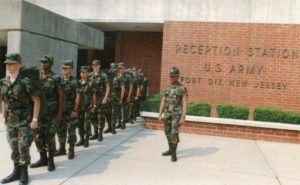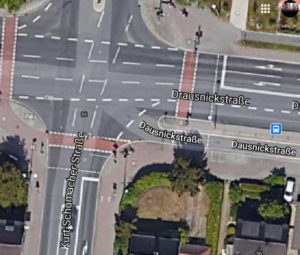What time is it, kids? It’s ‘Do Your Duty’ time. So, I enlisted in the Army on February 25, 1974.
The bus from New Haven to Ft Dix, NJ, filled up at the Port Authority Station in NYC. Two “long hairs” took the seats to my left, a semi-Italian 19-year old from Brooklyn, New York named Rios, and Keller who was fresh out of a Rikers Island prison cell.
We nodded, did not shake hands, and returned to our own thoughts while not knowing we’d become roommates in 3rd Plt, B-4-3. Madison from Patterson took the seat to my right. He was thin, 6′ 6″, assigned to 1st Platoon, and a prankster who I, weeks later, punched in broad daylight. (More later about James Henry Madison from NJ.)
The four of us glanced out the windows at the traffic, falling snow, and darkening skies as the bus rushed down the NJ Turnpike. Too soon it seemed we turned off and rolled through the Main Gate after MPs there checked the manifest. Runway lights blinked beyond the fence (McGuire AFB) outside on one side of the bus as USAF transport jets landed and took off.
We stopped at the Reception Station.
A burly, mean looking mad man in a Round Brown Hat boarded when the bus doors opened. He barked, “Listen up!” The lives of 50 ‘Swinging Richards’ were about to change.
The Drill Sergeant then said, “When I tell you to move, and not before then, you will stand up, grab your large yellow envelope with your papers and AWOL bags, un-ass this bus, line up with your toes touching the yellow line, and stand by for further orders.”
“Move!”
We un-assed the bus. He never yelled or screamed. He just walked from our left to right pointing down at the yellow line as we lined up.
He continued, “Hold up your envelope in your right hand and hold the handle of your AWOL bag with your other. … Move! Now, raise your envelope up and read whose name is on it. If it is your envelope, lower your arm to your side. If it is NOT your envelope, keep it up at eye level and, when I tell you to, sound off with the last name, printed in large letters, on it. … Move!”
Somehow, all of us had managed to grab the correct envelope. Yet two guys in the second row, 20 feet apart, still held up their envelopes.
The Drill Sergeant stood in front of the first one and said, “Sound off!”
“Smith, sir,” Smith replied in a low voice, as snow quietly fell, and each snowflake slammed into the cement.
“Welcome to the United States Army, General Smith!” The Drill Sergeant then marched down the second row and stopped in front of the second guy holding up his own envelope.
“Name?”
“Smith,” Smith replied in an even lower voice that everyone toeing the yellow line heard.
No one laughed.
“Is your first name ‘John’, Smith?” asked the Drill Sergeant.
“Yes sir,” John Smith replied in a whisper heard around the world.
“Well, Admiral John Smith, General Eugene Smith must be your older wiser twin brother, ain’t that right?”
“Yes sir,” John Smith whispered.
The Drill Sergeant leaned in until the brim of his Round Brown Hat just barely touched Smith’s forehead, and then he growled, “You will address me as Drill Sergeant. Do you understand?”
“Yes, Drill Sergeant,’ Smith said loudly.
The Drill Sergeant then added, “I work for a living. Don’t call me sir.”
Then he said, “Now, when I tell you to move, you 50 Army volunteers will face to your left … Not yet, General Smith … and move in column by stepping off with your left foot, follow the Drill Sergeant by the door and line up standing behind the tables inside where the Drill Sergeant tells you to stand … Move! … Your other left, Admiral Smith.”
No one laughed out loud for we were too scared. But it was funny.
We followed the other Drill Sergeant into the building and lined up where he pointed, each of us behind an individual table. Then he said, “Place your yellow envelope in the slot below your tabletop and your AWOL bag on top of your table … Move!”
“When I tell you to, quickly take everything out of your AWOL bag, pockets, and concealed on your person, and place it on the table. You have 30 seconds. … Move!”
“Place your empty AWOL bag under your table.”
As we did so, Drill Sergeants moved in front of each table, surveyed the contents, and screamed at us to take everything out of our pockets, take off all hats, and removed all jewelry (except for wrist watches). They circled, surveyed, stirred each table’s stuff with a short stick, and directed those with them to place all weapons, drugs (except prescriptions), and contraband (which they pointed to) in the “large red barrels marked ‘Amnesty Box’ at the back of the room and then return to your desk.”
“Move like you have a purpose!”
A few fools actually had brought contraband. As fast as rabbits could run, they ran to the red barrels and dumped their “junk in the trunk.” It was chaos. Yet the Drill Sergeants calmly directed rush hour like the traffic squad in a Keystone Cops movie.
No one laughed.
“Now, place everything remaining on your table, except your wallet, into your AWOL bag, put your wallet in your pocket, grab your AWOL bag with your left hand, and retrieve your yellow envelop with your right hand. … Move!” … “Your other left hand, General Smith.”
No one laughed.
The next two days at the Reception Station were a blur. We were weighed, measured, issued uniforms, medically examined, inoculated, vaccinated, drilled on by dentists, had our head “shaved” by barbers using the # 1 clipper in 30 seconds flat, lined up everywhere, and hurried up and waited. I’m sure we ate three meals a day and were allowed to sleep 7 hours a night, but I don’t remember either eating or sleeping.
Then a “bus” took us 50 brand new Army volunteers to our new home for the next 7 weeks of more fun than a human being should be allowed to have, ever: Army Basic Training at B-4-3.
***
Tim Sumner is a retired career U.S. Army Military Policeman. His service included as a Drill Sergeant from 1983 to 1985. He co-founded 9/11 Families for a Safe & Strong America in 2004. And he is currently writing a yet to be named memoir.


